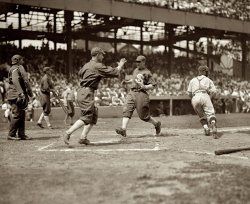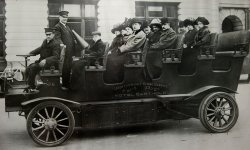
MAY CONTAIN NUTS

Search Shorpy
SHORPY ART

Framed or unframed, desk size to sofa size, printed by us in Arizona and Alabama since 2007. Explore now.
Join and Share
Ad-Free Shorpy
Shorpy is funded by you. Patreon contributors get an ad-free experience.
Learn more.

Recent comments
- Robie House Roof(s)
- There is an interesting novel set here.
- I Was In Berlin
- Pronunciation
- Shell of a Shell
- Never been there but
- BUR-lin
- Hand-made smokes
- Birthplace of Tupperware, or at least its inventor
- Pulp
- Remarkably unchanged in 84 years
- The church is still there ...
- Talk about a smoke show
- Electric Hansom Cab
- I wondered the same thing.
- The location in 2009
- Pill Pusher
- Roll your own
- Rugged and real!
- Civil War history
- Early EV?
- A Charles Purcell - Mama Cass Connection
- Uncle SAAM
- Obfuscation
- One Chocolate Soldier rode away
- Victor Marquis de la Roche
- The Little House Across Way ...
- Vanderbilt Gates
- Vanderbilt Mansion
- You can still see that gate
Member Photos
The Shorpy
Printporium
Printporium
Search Shorpy
Search results -- 30 results per page
- Let It Snow: 1940
- February 1940 in Chillicothe, Ohio. Guests in a hotel lobby watching the snowstorm. View full size. 35mm nitrate negative ... Posted by Dave - 12/21/2007 - 1:59am -
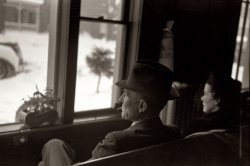
- Termite Terrace: 1901
- Miami circa 1901. "Hotel Royal Palm, west front." Henry Flagler's hostelry opened in 1897 and ... due to being buried underneath the garden in front of this hotel.
To tterrace Was this the building where Looney Tunes were born? ... Posted by Dave - 09/25/2014 - 5:37pm -
![Termite Terrace: 1901 Miami circa 1901. "Hotel Royal Palm, west front." Henry Flagler's hostelry opened in 1897 and closed in 1930, condemned after a termite infestation. 8x10 inch glass negative by William Henry Jackson, Detroit Publishing Co. View full size.
AmazinThat it didn't burn down before the termites got into it.
Current Issue of American Archaeology There is an article in the current American Archaeology Magazine on the the excavation of remnants of a Native American Tequesta village at this location. It probably escaped complete destruction in part due to being buried underneath the garden in front of this hotel.
To tterraceWas this the building where Looney Tunes were born?
[Well now, I wouldn't say that. -tterrace]
Let The Sun Shine InFlorida in the early 1900s, yet no window awnings? Wow, gotta love the heat to endure that. Then again I'm sure the hurricanes made short work of them.
[These hotels were winter destinations for their wealthy northern clientele. -tterrace]
(The Gallery, DPC, Florida, Miami, W.H. Jackson)](https://www.shorpy.com/files/images/SHORPY-4a08768a.thumbnail.jpg)
- Back on Track: 1907
- ... trip. It looks like a good walk from the depot to the hotel.
Plenty of Time to Enjoy Your Stay It won't be until 1977 that the ... Club's Highland Center.
The "Omni" Mount Washington Hotel, just up Route 302 in Bretton Woods, is still active. It's worth a stay ... Posted by Dave - 03/05/2017 - 6:48pm -
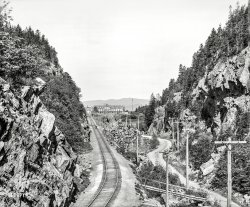
- Hanging Out: 1937
- ... "charters" in New Orleans) St. is now the Soniat House hotel.
Say "Cheesy" All trying to pose nonchalantly and not ... Posted by Dave - 07/19/2012 - 4:36pm -
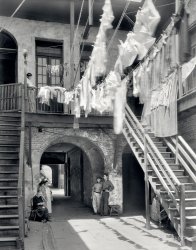
- Tourists of Doom: 1906
- ...
Now the "Renaissance San Francisco Stanford Court Hotel" is on the site at California & Powell streets in SF:
... Posted by Dave - 11/30/2016 - 6:34pm -
![Tourists of Doom: 1906 "Ruins of Stanford Mansion and Hopkins Art Institute, San Francisco." Aftermath of the April 18, 1906, earthquake and fire. 8x10 glass negative. View full size.
Look On the Bright Side...At least the lamps survived.
110 years onThere's a good pre-earthquake photo of the mansion from almost the same angle at:
http://www.ronhenggeler.com/the_big_4/1-15.htm
Now the "Renaissance San Francisco Stanford Court Hotel" is on the site at California & Powell streets in SF:
What's leftInteresting - that square utilities pole. Looks like possibly constructed of concrete. And, typical of devastating fires, nothing left except for the chimneys.
Before and AfterI found this image from nearly the same spot before the fire. The burned tower in the background of the Shorpy photo is still under construction in this image.
Caught off guardAn interesting cross-section of the city's population, including three U.S. Marines, captured apparently unaware of the photographer's presence. It would seem that a relatively fast-acting camera was used, based on the motion captured in the frame.
[Daylight exposures of fractions of a second were commonplace by this time. -tterrace]
Well dressed even in disaster...Amazing how well turned out these people are in the midst of their ruined city complete with attractive hats, coats and dresses. They even have their Brownie cameras in tow (I am guessing that is what is being carried by the man in the foreground)
How Long After ?I wonder how long after the fire that this was taken? The large utility pole seems to have more guy wires anchored to it than service wires on its cross arms while another wooden one (without any wires) looks, fresh even with all the spiked-boot climbing evidence on it.
Also, the irony of the fire hydrant - likely rendered useless if the quake sheared the mains supplying it. Some SF buildings had private cisterns, which in a few rare cases mitigated damage.
Another curious survivorThe monkey puzzle tree in the front yard.
(The Gallery, DPC, Fires, Floods etc., San Francisco)](https://www.shorpy.com/files/images/SHORPY-4a13257a.thumbnail.jpg)
- A Chat With Marilyn: 1953
- Marilyn Monroe in 1953 at the Banff Springs Hotel while in Canada to film River of No Return . Photo by John Vachon for ... Posted by Dave - 07/18/2013 - 7:22pm -
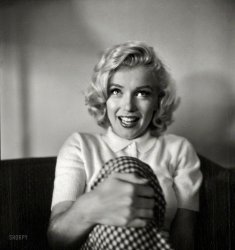
- Welcome to Denver: 1908
- ... the street there.
My kind of place ! The Oxford Hotel looks like my kind of place. Cigars on one side, bar and restaurant on ... Posted by Dave - 04/17/2014 - 9:35am -
![Welcome to Denver: 1908 Click here for a view of the arch from the depot.
Denver, Colorado, circa 1908. "Welcome arch and Union Depot." Where blurry pedestrians risk the retoucher's brush. 8x10 glass negative. View full size.
Because ...that's much less noticeable than a blurred pedestrian, right?
+104Below is the same view from July of 2012.
SuperheroI think that might be the Human Torch crossing the street there.
My kind of place !The Oxford Hotel looks like my kind of place. Cigars on one side, bar and restaurant on the other and a nice group of chairs in the middle! Time to sit down and have a smoke!
Photo RetouchingBy the time this photo was taken in 1908, the airbrush had been around for nearly a decade. It's level of sophistication and ease of operation may not have been quite on par with modern machines, but would have definitely done a better retouching job on the blurred pedestrian than this feeble attempt done by a regular brush. From someone who did his share of photo retouching the old school way with an airbrush, retouch grays, and frisket paper, let me tell you that I love PhotoShop immensely.
[The actual "retouching" would be done while preparing the lithograph printing stones, in effect repainting the area. My guess is that the scratching out of the pedestrian was a method of calling attention to the necessity of doing so. -tterrace]
Right you are! My remarks would only pertain to photographic print retouching. Thanks!
Modern advertising skillsThe Depot Drug Store's slogan, painted on the side of the building, is "Come In and Wait". I'm not sure that kind of slogan would work today.
Welcome ArchShortly after this photo was taken, this side of the arch was changed to "Mizpah" - Hebrew for "God watch over you while we are apart" - after some citizens pointed out that "Welcome" didn't make sense for people passing under as they departed. "Welcome" remained on the arrival side until the arch was declared a traffic hazard and removed in 1931. The central portion of the depot lost its tower when it was rebuilt in Romanesque style in 1914
WhenWas the Arch installed and by whom?
(The Gallery, DPC, Railroads, Stores & Markets, Streetcars)](https://www.shorpy.com/files/images/SHORPY_4a23004a.thumbnail.jpg)
- Finials Galore
- ... they were taken.
[It's Washington, D.C.'s Mayflower Hotel, previously seen here on Shorpy. -tterrace] View full size.
... Posted by John.Debold - 02/17/2017 - 8:16pm -
![Finials Galore Picked up a set of about 5 of these 8 x 10 architect's photos (in oak frames) way back in the 1990s. Do not know where they were taken.
[It's Washington, D.C.'s Mayflower Hotel, previously seen here on Shorpy. -tterrace] View full size.
(ShorpyBlog, Member Gallery)](https://www.shorpy.com/files/images/Architect_Photo_Building758-001.thumbnail.jpg)
- The Shining: 1908
- ... with flash Here I've recreated the effect in my hotel room. This was a 5 second exposure with the flash firing at the start of ... Posted by Dave - 12/19/2015 - 12:27pm -
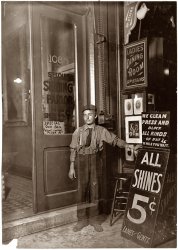
- Here Come the Bridesmaids: 1924
- ... The happy couple planned to move into the Wardman Park Hotel, home of many a Shorpy subject, to await the groom's return to service in ... Posted by Dave - 10/28/2016 - 12:52am -
![Here Come the Bridesmaids: 1924 May 6, 1924. Arlington, Virginia. "Byars-Coontz wedding." The union of Miss Virginia Byars to Lieut. Kenneth Lee Coontz, son of Admiral Robert Coontz. National Photo Company Collection glass negative. View full size.
Little boy lostPresumably the usher standing with arms crossed amidst encroaching bouquets. His outfit was not designed to bring a smile to his face.
[He's most likely the ring bearer, and his feminine counterpart the flower girl. -tterrace]
Can I go now?That little boy looks thrilled to be part of the festivities.
Tragic end to the union?ADM Coontz served as the second Chief of Naval Operations. His son, the groom, died on active duty, apparently two years after this photo was taken, and was interred not far from wherever this photo was taken in Arlington. See here.
A somber occasionAs my late mother would say, when taking a picture, "Would it kill you to smile?"
Ghastly GarmentsIt's nice to know that bridesmaids dresses have always been useless once the wedding is over. And what's with the bride, who looks like she's trying to figure out a way to get out of the wedding?
Virginia lived a long lifeUntil the age of 98.
Groom & doomThe wedding earned an entire column of coverage in the May 7, 1924 New York Times. The matron of honor in this photo was the First Lady of Virginia and the flower girl, her daughter. The happy couple planned to move into the Wardman Park Hotel, home of many a Shorpy subject, to await the groom's return to service in the Pacific that fall.
In its brief September 26, 1926 report on Lt. Coontz's death, the Times stated that it followed an illness of more than a year, and that he had undergone several major operations. The Associated Press had mentioned cancer.
Son of the brideObituary here.
(The Gallery, D.C., Kids, Natl Photo, Weddings)](https://www.shorpy.com/files/images/SHORPY-11311u.thumbnail.jpg)
- Pilot Project: 1938
- ... Mail Week essay contest at a dinner held at the Mayflower Hotel.
Runners-up were Ellen Peak, of Manhattan, Kans., who received a ... Posted by Dave - 12/15/2013 - 11:14pm -
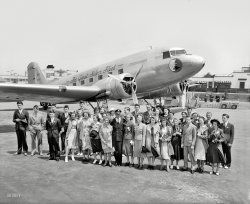
- DeLovely: 1904
- ... food.
At the time there was an abandon, two story, wood hotel at the springs. My grandmother told me it closed down when a guest had ... Posted by Dave - 01/04/2013 - 8:55pm -
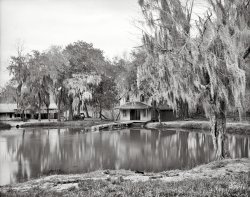
- Florida Times-Union: 1904
- ... this building at 136 W. Bay Street became the Atlantic Hotel. An article in The Florida Times-Union was about a character they ... 1921, on the premise of scaling the front of the Atlantic Hotel, a three-story building at Bay and Hogan streets."
(The Gallery, ... Posted by Dave - 08/09/2012 - 7:14pm -
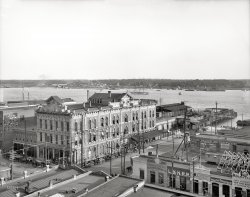
- Magic Fingers: 1970
- ... U.S. Senate in Michigan, and meeting with son Mitt in her hotel room in Marquette." Note the "Magic Fingers" coin box. Photo by Douglas ... Posted by Dave - 06/12/2013 - 4:06pm -
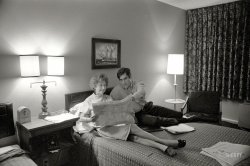
- Our Staff: 1900
- ... Dixville Notch, White Mountains, New Hampshire." The hotel staff, all of whom are upstairs these days. View full size.
Axle ...
Lettie fell off the train on the spur in front of the hotel one afternoon and hit her head, although some thought Jack pushed her. ... Posted by Dave - 11/12/2012 - 8:45pm -

- A Merry Xmas: 1940
- ... at Christmas dinner in the Australian Club (old East Hotel) in Jerusalem between 1940 and 1946. View full size. Matson Photo ... Posted by Dave - 12/16/2007 - 8:15am -
![A Merry Xmas: 1940 Australian soldiers at Christmas dinner in the Australian Club (old East Hotel) in Jerusalem between 1940 and 1946. View full size. Matson Photo Service.
A bit of homeThe beer is Ballarat Bitter and the leaves on the walls look like eucalyptus, which with its unique smell would have so reminded them of home.
Merry Xmas?Wouldn't an Australian Club have used Happy Xmas on their banner hanging above?
Seems like the Brits used Happy Christmas as a greeting.
[Maybe it's a British-made banner? - Dave]
Australian XmasBetween '40 and '46 there was a major altercation . . .
Ballarat Bitter?No wonder they look so down in the mouth. They're drinking poor quality Victorian beer. Ballarat Beer and at war... Could life be any worse?
Of course it could be worseThe could be drinking American beer. Or Fosters.
HandsomeI'm in love with the man in front, second from right. When we get the time machine up and running, I'm booking passage to the time and place in this picture. First, though, I'd have to stop in about 1980 and get myself back to how I looked then!
(The Gallery, Christmas, Matson)](https://www.shorpy.com/files/images/14498u.thumbnail.jpg)
- Tierra del Fuego: 1900
- ... 1900. "The beach at Old Orchard, Maine -- Ocean Pier and Hotel Velvet." Which, following the curiously inevitable destiny of beach ... Posted by Dave - 11/04/2016 - 11:18pm -
![Tierra del Fuego: 1900 Circa 1900. "The beach at Old Orchard, Maine -- Ocean Pier and Hotel Velvet." Which, following the curiously inevitable destiny of beach resorts surrounded by ashtray-grade sand and literal oceans of water, "burned like oil" in the Great Fire of 1907. 8x10 glass negative, Detroit Publishing Co. View full size.
Re: BathsA cold saltwater bath was probably warmer and more relaxing than bathing in the frigid Maine surf. As for hot baths, I can only wonder what happened to those. Saltwater is very therapeutic, and a hot salt bath sounds most rejuvenating. I wouldn't be surprised if they make a trendy comeback in beachfront spas.
PiersMy guess, based on living in towns that took pride in their piers, is that they were used for fishing. It was also nice to just stroll out to the end of the pier and not jump in.
BathsI bet the "Cold Salt Water Baths" advertised were just a joy to be partake in.
[Hot also available. -tterrace]
Always the same endingSo when did it burn?
[Funny thing about the captions for these photos... - tterrace]
Old Orchard Beach PierHaving spent many summers of my youth in Old Orchard I got to see a few different phases of the Pier. The one that remains there now is only about 5oo feet in length, the original was over 1600 feet long. Like many old beach resorts in the north east the combination of fire and storms are often the merchants of change.
Pier attractionSo many of the pictures of seaside hotels, resorts, etc have long piers extending a long way out to sea. What was the attraction?
the firePhoto here.
Out on a limbThe lady sitting all alone in the foreground, head bowed.
[Those are two women. -tterrace]
(The Gallery, DPC, Swimming)](https://www.shorpy.com/files/images/SHORPY-4a07990a.thumbnail.jpg)
- Shaken & Singed: 1906
- ... The building at far left in the "today" view is the Palace Hotel. Originally built in 1875 by William Ralston and opened right around the ... Posted by Dave - 05/24/2022 - 2:37pm -
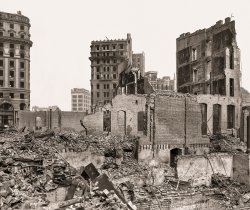
- National City Bank: 1912
- ...
From U.S. Custom House > Bank HQ > Luxury Hotel > Condos: all while its cousins in other cities were consigned to the ... Posted by Dave - 04/18/2022 - 4:13pm -
![National City Bank: 1912 New York circa 1912. "National City Bank, Wall Street at William Street." Also the Atlantic Building, and a sliver of U.S. Trust. Detroit Publishing Company glass negative. View full size.
Piggy-back... if not "piggy bank". They don't build 'em like this anymore (actually, they didn't even build 'em like this then: the upper floors were a later addition.)
From U.S. Custom House > Bank HQ > Luxury Hotel > Condos: all while its cousins in other cities were consigned to the landfill in their youth ... some buildings have all the luck !!
110 years laterIt's a scarier world on Wall Street; here and look to your right.
The Merchants' ExchangeThis building has an extraordinary architectural history. It was built in 1836-1841 as the Merchants' Exchange, designed by architect Isaiah Rogers from Boston. The original building consisted of only the lower three stories, with the Ionic colonnade, and a big dome in the center of the block. As such, it was clearly modeled after Karl Friedrich Schinkel's Altes Museum in Berlin, built 1822-1828. From 1862 on it served as the US Custom House, which had been housed in what is now called the Federal Hall National Memorial (aka the Subtreasury) at Wall Street and Nassau Street. When the Custom House moved out to occupy Cass Gilbert's Beaux-Arts extravaganza facing Bowling Green, the National City Bank bought the building and hired McKim, Mead and White to expand it (1907-1910). Charles F. McKim decided to double the building in height by adding four more stories with a Corinthian colonnade on top of the original Ionic structure, while creating an entirely new interior with an impressive domed banking hall at the center. He integrated his addition so well that you would hardly suspect it was ever added in the first place!
One pieceThe Bank building with its formidable pillars began life as the Merchants Exchange building. Those pillars came down the Hudson River -- and are one piece of stone -- no joints.
[There are joints in the upper columns. - Dave]
Melville's neighborhoodHerman Melville worked as a customs inspector in New York from 1866 to 1885. His work was around the wharves, and inspectors had to rent their own work space nearby. But he would have been in and out of this Custom House over two decades.
Melville was paid four dollars a day for a six-day work week. He never received a promotion or a raise in pay.
(The Gallery, DPC, NYC)](https://www.shorpy.com/files/images/SHORPY-4a25611a1.thumbnail.jpg)
- A. Foulke: 1864
- ... a Daughter in law and a new son George. He was running a hotel in 1870. The proof came in a Washington DC city directory for 1865 where ... Posted by Dave - 06/15/2012 - 1:08am -
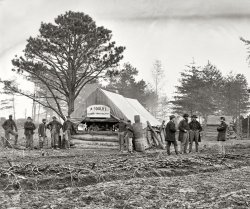
- High Life: 1963
- ... architect, 1927-1929, now the InterContinental Chicago Hotel); the Tribune Tower (John Mead Howells and Raymond Hood, architects, ... Posted by Dave - 12/07/2016 - 1:15pm -
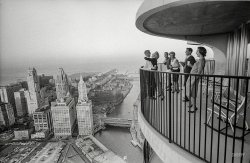
- Welcome D.U. Bathrick: 1946
- ... 24, 1946. "Pontiac zone managers' banquet at St. Francis Hotel." 8x10 acetate negative, originally from the Wyland Stanley collection. ... Posted by Dave - 04/19/2015 - 7:45pm -
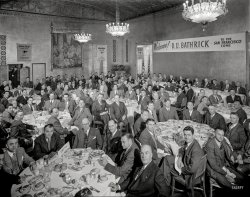
- King Dodo: 1910
- ... the night of December 4, 1919. The Four Points Sheraton Hotel now occupies the site.
King Dodo A synopsis of the plot of King ... Posted by Dave - 06/11/2013 - 1:33pm -
![King Dodo: 1910 1910. "French Opera House, New Orleans." Coming March 20: "King Dodo," a "phosphoronic comedy opera." 8x10 glass negative. View full size.
LogicalIf you're gonna have an 'Opera House', you're gonna need an 'Opera Saloon'.
Fire escapes?I count two fire escape landings, both sharing the same vertical ladder. Not very reassuring in the event of a fire during a packed house.
Let's hope the back of the opera house featured multiple fire escapes with wide, steel staircases instead of ladders. Right.
In need of paint?Can someone explain whether the upper story is in need of a paint job, or if the finish shown is some New Orleans distressed style of decorating?
While we're at it, is this interesting building still standing?
How oddNot a sign of life.
[There's at least one ghost. -tterrace]
Hear the Eminent Doctor Fizz!A recording of "Gems from King Dodo," recorded in 1912. http://www.loc.gov/jukebox/recordings/detail/id/2761/
Only 9 years to goOpening in 1859 and fast becoming the social hub of New Orleans, the French Opera House on Bourbon at Toulouse Street was destroyed by fire on the night of December 4, 1919. The Four Points Sheraton Hotel now occupies the site.
King DodoA synopsis of the plot of King Dodo, along with some other information.
(The Gallery, New Orleans)](https://www.shorpy.com/files/images/SHORPY_4a19855a.thumbnail.jpg)
- Walk Your Horse: 1910
- ... a predecessor. You can see the upper facade of the Capital Hotel (still there, at 111 West Markham Street) rising over other buildings ... Posted by Dave - 08/14/2012 - 7:13pm -
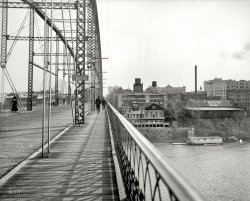
- Me and My Shad: 1920
- ... was later collected in the masterpiece "Up in the Old Hotel."
Joseph Mitchell was from a small town in North Carolina; after ... Posted by Dave - 09/13/2011 - 1:33pm -
![Me and My Shad: 1920 Circa 1920. "Shad fishing on the Potomac." National Photo Co. View full size.
"Gluttonous Springtime Blowouts"Here's a quote about shad bakes from catfish1.com
During the shad's Hudson River heyday, virtually every river town could boast at least one big annual shad bake—the Hudson's equivalent of the New England shore dinner. New Yorker essayist Joseph Mitchell, in his 1959 piece "The Rivermen," calls these bakes "gluttonous springtime blowouts" and remembered when huge bakes were given by churches, lodges, labor unions, and local politicians.
"The Rivermen" was a long essay for the New Yorker. It was later collected in Mitchell's "The Bottom of the Harbor," which itself was later collected in the masterpiece "Up in the Old Hotel."
Joseph Mitchell was from a small town in North Carolina; after graduating from college, he moved to New York, where he reported for several newspapers and eventually began writing for the The New Yorker in 1933. He worked there until his death in 1991, although he effectively stopped writing in 1964. Shorpyites who are fascinated by the old urban photos, especially of New York City, would likely be fascinated by Mitchell's writing.
Bad shadI've always thought of shad as a trash fish. Were they considered more desirable in 1920 or is there something I don't know about them?
[Planked shad was practically a religion in this part of the country. And shad roe is considered a delicacy by many. - Dave]
Blind to their Own InterestsShad were once plentiful in the Potomac, Delaware and Hudson rivers. Overfishing and pollution were greatly reducing their numbers at the time of this photo. Due to efforts to stock the river with fry and roe, the population in the Potomac lasted a few years longer then those in the Delaware and Hudson. There is now an ongoing project to restore shad to the river.
On a culinary note, in addition to planked shad for dinner, newspapers of the time mention bacon-garnished shad roe as a popular breakfast treat. Of course making a delicacy of the thousands of eggs in each fish no doubt hastened their decline.
Additionally, please don't interpret the title of this post (Blind to their Own Interests, extracted from one of the following newspaper articles) as a condemnation of the hard-working fishermen of the time. Overfishing, as in many exploitations of shared resources, is due to the larger dilemma of the Tragedy of the Commons.
Washington Post, Dec 20, 1915
Driving Out Potomac Shad
Fish Will be Gone Says Commission,
if Greedy Catch Isn't Stopped
Unless protective measures are taken at once by the State of Maryland and Virginia there is a danger that the shad, the most valuable of the migratory river fishes of the Atlantic seaboard, will become unknown in Chesapeake Bay and the Potomac River.
A real note of alarm in this respect was sounded in the annual report of the government bureau of fisheries, which was issued yesterday. Not only is it indicated that the fisheries laws of Maryland and Virginia should be amended, but the laws of all the Atlantic coast States as well.
"The bureau repeatedly has pointed out the shortsighted and destructive course pursued by some of the States with reference to this most important fish," the report said. "The most serious condition exists in the Chesapeake basin, where in 1915, the fishing was the poorest ever known, following a season that was the poorest in a generation. No limits are placed on the operations of the fishermen, who seem blind to their own interests. Every stream which the shad can try to ascend is literally choked with nets.
Washington Post, Nov 27, 1925
Fish Disappearing
Commissioner O'Malley, of the Bureau of Fisheries declares in his annual report that the country is at last awakening to the need of conservation if serious depletion of some of the most important American fisheries is to be checked. ...
A few years ago shad visited the waters of the Potomac in sufficient numbers to enable the proprietors of the resorts along the shores between Washington and Indian Head to offer a round trip ticket on their steamers with a "whole planked shad and a moonlight ride on the return," all for a dollar. In those happy days fishermen offered the choicest "roe shad " at the height of the season for "a levy," and itinerant peddler would bring one to your door, all dressed, for a quarter. Frequently when the fish were "runnin' strong" they were a drug on the market, to be had for carrying them away. Farmers along both shores of the river salted hundreds of barrels of shad and herring every spring, while "Potomac Robins," as the herring were known, were the staple food of most of the colored laboring class.
1914 Advertisement
Washington Post, Jul 22, 1926
Will The Shad Come Back?
...
Thousands of citizens not yet out of the "thirties" can remember when the fish peddler cried his wares through the streets of Washington early in the spring when a roe-shad big enough for a family dinner could be purchased for a "quarter." But there has been a gradual falling off in the catch every year for more than a decade and last May, in the height of the season, the haughty fishmonger scorned the dollar proffered for an insignificant "buck."
The United States fish commissions has carried on restocking operations in the Potomac during the past nine or ten years. This season the number of fry turned into the river at the hatchery opposite Mount Vernon was the smallest in years. There were 10,000,000 fingerlings released from the hatchery. In some years the number has reached 80,000,000 and the commissioner is still hopeful that results will be shown in the returns from the seine haulers.
The falling off in the number of shad caught in Northern waters can only be explained by the growth of cities on the banks of the rivers and the erection of all sorts of manufacturing plants along the shores which have resulted in the pollution of the waters and killed off young fish by the millions. ...
Oh, waiterThe popularity of shad roe is illustrated in the Cole Porter song "Let's Do It" with the line "Why ask if shad do it? Waiter, bring me shad roe."
Fish storyShad fishing in the Hudson River remained a major seasonal activity until well into the 1950's: the rivermen would live on their boats/barges during the shad run. Some time earlier, large sturgeon were plentiful enough on the Lower Delaware that there was a town (Caviar) built around the harvesting of their roe. The Central Railroad of New Jersey had a freight line serving the town.
Not much left of that now.
ShadHere on the Tennessee river, shad are used for cut bait on trot lines. You have to cut up a shad and get the pieces on the hooks as they don't "keep very well" in warm weather.
(The Gallery, Boats & Bridges, D.C., Natl Photo)](https://www.shorpy.com/files/images/18293u.thumbnail.jpg)
- Crown Restaurant: 1904
- ... have never known that Mr. Traphagen designed the Moana Hotel on Waikiki Beach, and they he hailed from Duluth. I have strolled past that hotel and had a few drinks on its veranda overlooking the beach.
... Posted by Dave - 12/22/2014 - 11:09am -
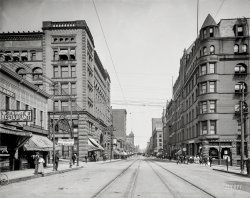
- International Newsreel: 1924
- ...
Mr. Van Tine, who lived at the Roosevelt Hotel, 2101 16th st. nw., is survived by two granddaughters, Mrs. Cyril J. ... Posted by Dave - 02/09/2012 - 1:52pm -
![International Newsreel: 1924 Washington, D.C., 1924. "Van Tine & Johnson." Harry Van Tine and Joe Johnson in a photographic survey of Washington-area lensmen. View full size.
International Newsreel Corp.That's confusing - if they're newsreel lensmen, why the still cameras, a 4x5 Graphic and 5x7 Graflex? I'll need to dig into this one.
[International Newsreel was a photo agency whose pictures appeared in many newspapers. - Dave]
Perfect typesThese look exactly like the guys you would see in a 1930s movie, brandishing flash cameras, with a card reading "Press" stuck into their hatband.
Graflex shootersThe camera between them appears to be an early Graflex single lens reflex.
Walking all over town those shoes could use a spit shine.
Could it be Lincoln's church?The building in the right background is the old Masonic Hall on New York Avenue, which would seem to put these two gentlemen on the roof of the old New York Avenue Presbyterian Church, the church attended by Abraham Lincoln, which was torn down in 1950. I'm not sure where they'd fit up there, however--possibly on a ledge on the clock tower? Perhaps it's more likely that they're on the roof of one of the buildings nearby on H Street, such as the Times-Herald Building, which would be very fitting.
Pappy Van Tine
Washington Post, May 2, 1968.
Lensman Harry Van Tine Dies.
Harry M. Van Time, who snapped exclusive photos of Harry K. Thaw escaping from a mental institution in 1915 and took the first still pictures of actress Mary Pickford, died Tuesday at Washington Hospital Center after a two-month illness. He was 82.
Mr. Van Tine, known throughout his professional life as "Pappy" and "Van," retired in the 1950s after 40 years with International News Photos. He was dean of the White House News Photographers Association and one of its founders.
Born in Beacon, N.Y., he was working for a newspaper chain in the Hudson Valley when Thaw, who had murdered the famous architect, Stanford White, escaped from Matteawan State Hospital.
His photos helped him to land a job in New York soon after that and by 1914 he was working for INP, covering championship boxing matches, taking photos from early and makeshift airplanes, and photographing Barney Oldfield winning the Sheepshead Bay auto race.
He took still photos of Mary Pickford when she was a young girl appearing in "The Call [Song] of the Wildwood Flute" and he was there with his camera when a midget was planted into J.P. Morgan's lap.
Mr. Van Tine came to Washington in 1917 on assignment, covering the arrival of French Marshall Joffre and Italian Minister Marconi, and decided INP needed a Washington bureau. He became that bureau and was with it from then on.
Things were more casual then around the White House and the photographers harder to handle. Mr. Van Tine wanted to get a photo of President Wilson basking in the sun on the White House lawn, so he hid in a load of hay that was headed for sheep which then grazed behind the White House. But he was discovered by Secret Servicemen.
Mr. Van Tine was the first vice president of the White House News Photographers Association. He served later as president and was for ten terms the organizations secretary-treasurer.
Mr. Van Tine, who lived at the Roosevelt Hotel, 2101 16th st. nw., is survived by two granddaughters, Mrs. Cyril J. Pittack, of 601 Four Mile rd., Alexandria, and Mrs. Al Kimbrough, of Reno, Nev.
Van Tine's cameraHarry Van Tine was my great grandfather. We still have that camera.
Thank youThis is the first time I have been able to see my Great Grandfather Harry
(The Gallery, D.C., Natl Photo)](https://www.shorpy.com/files/images/SHORPY_11324u.thumbnail.jpg)
- The Hollenden: 1900
- Cleveland, Ohio, circa 1900. "Hotel Hollenden." 8x10 inch dry plate glass negative, Detroit Publishing ... Posted by Dave - 07/30/2012 - 11:17pm -
![The Hollenden: 1900 Cleveland, Ohio, circa 1900. "Hotel Hollenden." 8x10 inch dry plate glass negative, Detroit Publishing Company. View full size.
Oh, it's a trash receptacle!Dave, You are correct, by cracky. Me and Mr. Magoo have the same kind of problems.
I cannot have ANY of them!I just happened to notice that a few of my "forbidden" indulgences are lined up in this picture as is the doctor's list in my conscience:
Riblets (small, meaty pork ribs)
Cigars
Coffee
Dairy (way over on the right)
Uneeda biscuit (on the mailbox)
What was the average age of expiraton expected in 1900? Where is the salad and produce? Tofu? Soy? Maybe it just SEEMS like we are living longer.
[Just wondering -- do you find that your postcards, Christmas cards and such never seem to reach their intended recipients? - Dave]
May the road rise up to meet youInteresting to note that it appears as if the road rises up to meet the curbs to form crosswalk locations, instead of using curb cuts the other way round.
What's the difference...?between an elephant and a mailbox?
If you have to ask, don't offer to mail any letters for me.
Sorry, very old joke.
It amazes mehow prevelant cigars were in the early 20th century. In some of the pictures, there seem to be numerous prominent vendors everywhere. It must have been a major industry in its own right.
A bit moreThe Hollenden page at coolhistoryofcleveland. Stages, barbershops and "The Vogue Room" were all part of the story. One Thousand Rooms ... one hundred bathtubs. Hmmm
(The Gallery, Cleveland, DPC)](https://www.shorpy.com/files/images/4a08596a.thumbnail.jpg)
- Electric Sight-Seeing in N.Y.
- ... heavy coats and all have rugs over their knees. The Hotel Bartholdi, it seems, was well known in the period, and a search reveals ... 16 inches. I would like to know more about Green Car, the Hotel, and Lansden. View full size.
- Roverdriver in Australia
... Posted by roverdriver - 09/19/2011 - 11:33pm -
- Welcome Home: 1925
- ...
However, two incidents stand out. In 1927, in a hotel room in Shreveport, Louisiana, "Bananas" took a razor to himself, ... Posted by Dave - 08/03/2012 - 3:02pm -
